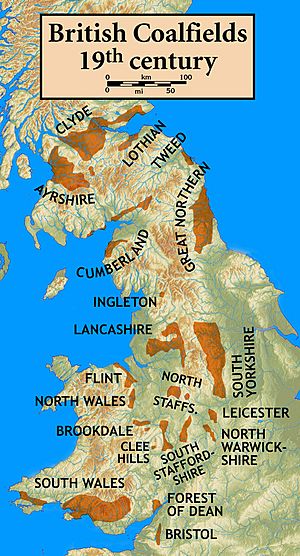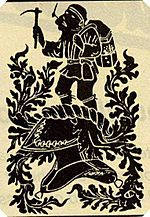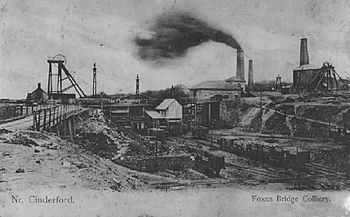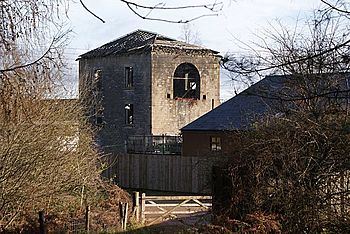Forest of Dean Coalfield facts for kids
The Forest of Dean Coalfield is a special area in west Gloucestershire, England. It's known for its coal, which has been mined for hundreds of years. Even though it's one of the smaller coalfields in the United Kingdom, mining has greatly shaped the land, history, and way of life here.
What makes this coalfield unique is a system called freemining. This means that certain people, called freeminers, can get special permission to dig for coal in specific areas. This old tradition was even kept when the coal industry was nationalized in 1946, showing how important it is to the Forest of Dean.
Most of the big mines closed in 1965. Today, only a few small mines are still working, but freemining remains a big part of the area's culture.
Contents
How the Coalfield Formed
The Forest of Dean Coalfield was created a very long time ago, during a period called the Upper Carboniferous. Back then, this area was a mix of shallow seas, river mouths, and swamps. Over millions of years, dead plants piled up and turned into coal.
Today, the area looks like a raised bowl of old rocks. It's shaped like a giant dip or valley, called a syncline, which has been pushed up. The edges of this "bowl" are mostly visible on the surface, which is quite unusual for a coalfield.
Water, Water Everywhere!
Mining here has always faced a big challenge: too much water underground! The bowl shape of the rock layers traps water. Rainwater soaks into the ground, and streams also flow into the basin.
Many streams in the area flow over clay, which doesn't let water through. But where valleys cut through the edge of the basin, water can seep into the ground through cracks and holes in the limestone and sandstone. Water also enters through natural breaks in the rock, called faults.
To deal with this, many mine owners tried to "waterproof" the stream beds. They built channels or pipes to stop water from leaking into the mines. You can still see these old drainage features along many waterways in the mining area.
The Special System of Freemining
For hundreds of years, mining in the Forest of Dean has been controlled by the freemining system. If you meet certain rules, you can get a lease to mine a specific area.
It's believed that freemining rights were first given by Edward I of England as a reward. This was because freeminers helped recapture a town called Berwick upon Tweed several times in the late 1200s.
The freeminers used to have their own court, called the Free Miner's Mine Law Court, which met at the Speech House. The oldest known book of their laws, called the Book of Dennis, dates back to 1610, but it mentions even older rules.
Changes Over Time
As the Industrial Revolution began in the late 1700s, there was a huge demand for coal and iron. This led to many arguments over mining rights, and the freeminers' court became very busy. The King wanted to open up the Forest to more businesses. So, in 1777, the Mine Law Court was shut down, and its documents were taken away.
In 1831, a special group was set up to look into freemining. This led to the Dean Forest Mines Act of 1838. This law confirmed that freeminers had the special right to mine in the Forest of Dean. But it also allowed them to sell their mining areas to people who were not freeminers. This opened the door for bigger companies to get involved.
A modern change happened in 2010. Before then, only men could be freeminers. Now, women are also allowed to become freeminers, continuing this unique tradition.
How Coal Was Mined Over the Years
People started mining coal in the Forest of Dean even before the Roman Empire existed. These early mines were small. For a long time, iron mining was more important, so coal was often just a side product.
In the 1600s, a man named Edward Terringham was given a special right to mine coal. This upset the freeminers, leading to fights. To mine more coal, Terringham built a drainage tunnel and brought in workers from other areas. Later, he gave up his lease. Around 1680, about 25,000 tons of coal were being shipped out of the area using the River Wye.
The Industrial Revolution and Beyond
The coalfield really took off during the Industrial Revolution. This was when factories needed a lot of coal to make iron. At first, it was hard to make good coke (a type of fuel made from coal) from the local coal for smelting iron. This caused some early ironworks to fail.
However, around 1820, a man named Moses Teague found a way to make good iron using local coke. This was a huge step forward for both the iron and coal industries in the Forest of Dean.
By the mid-1800s, there were over 300 coal mines or workings. People even said that more men worked underground than above ground!
When the Coal Industry Nationalisation Act 1946 was passed in 1946, it took control of most coal mines in the UK. But the Forest of Dean was special. Because of its unique history and freemining system, it was left out of the Act. Some larger mines were later bought by the National Coal Board (NCB), but they still followed the freemining rules. The NCB even paid royalties to the freeminers for the coal they took out.
In 1945, half the men in the Forest of Dean worked in coal mining. The last big NCB mines closed in 1965. But freemining is still a very important part of the Forest of Dean's culture. There are still about 150 freeminers today, even though only a few small mines are still active.
Famous Collieries (Mines)
The mines, or "gales," were often small and had very creative names. Some were called Strip and At It, Gentleman Colliers, or Rain Proof. They dug coal from different layers, or "delfs," named Rocky, Lowery, and Starkey.
Sadly, children were used to drag coal underground until 1842, when it became illegal.
In 1904, some mines joined together into seven bigger groups. This allowed them to mine on a larger scale from deeper coal layers. At its peak, the coalfield produced one million tons of coal each year! After World War II, output went down. The last big mine closed in 1965. Today, coal is still mined, but on a very small scale.
Here are some of the notable collieries:
- Arthur and Edward (also known as Waterloo) near Lydbrook. In 1949, this mine flooded, but one miner knew an old escape route and led his four friends to safety.
- Bilson produced 4,482 tons of coal in 1880.
- Crump Meadow produced 75,173 tons of coal in 1880. It had special engine houses to pump water and lift coal. It operated for 105 years, starting in 1824.
- Foxes Bridge produced 126,978 tons of coal in 1880. It closed in 1930.
- Lightmoor produced 60 tons of coal in 1880. This mine lasted for a century, closing in 1940. Its deep shaft went down 936 feet and passed through 18 coal layers.
- New Fancy produced 8,382 tons of coal in 1880. It closed in 1944.
- Northern United opened in 1933 and closed in 1965. It reached the Coleford High Delf coal layer at a depth of 700 feet.
- Princess Royal produced 2,665 tons of coal in 1880.
- Trafalgar produced 88,794 tons of coal in 1880.
Images for kids
See also
- List of coalfields (Great Britain)
- Forest of Dean Miners' Association
- Cinderford Ironworks
- Whitecliff Ironworks
- Parkend Ironworks







